crops
 The normal hurricane season is from June 1 to November 30, and since we have our first hurricane in the Gulf of Mexico right now, it looks like it’s right on time. Nevertheless, for places like New York, where it is normally a little cooler, the hurricane season starts a little later, and may not really arrive at all. However, on June 4, 1825, a rare early hurricane arrived, moving off the East Coast and tracking south of New York. The hurricane caused several ship wrecks, and killed seven people.
The normal hurricane season is from June 1 to November 30, and since we have our first hurricane in the Gulf of Mexico right now, it looks like it’s right on time. Nevertheless, for places like New York, where it is normally a little cooler, the hurricane season starts a little later, and may not really arrive at all. However, on June 4, 1825, a rare early hurricane arrived, moving off the East Coast and tracking south of New York. The hurricane caused several ship wrecks, and killed seven people.
The National Hurricane Center, states that on average, hurricane winds have impacted the New York City area every 19 years, and major hurricanes, of a Category 3 or higher, only every 74 years. The highest hurricane reading, Category 5 hurricane is not expected to occur there at all, because of the climate conditions there.
Nevertheless, on June 4, 1825, forming ahead of what is now considered hurricane season, a severe tropical storm surprised the Atlantic seaboard from Florida to New York City. At that time, they did not have the prediction capabilities, and this storm was first sighted near Santo Domingo on May 28th. It moved across Cuba on June 1st, with gale force winds,  beginning at Saint Augustine, and approaching US soil on the June 2nd, and impacting Charleston, North Carolina on June 3rd.
beginning at Saint Augustine, and approaching US soil on the June 2nd, and impacting Charleston, North Carolina on June 3rd.
The tide in North Carolina rose six feet at New Bern and fourteen feet at Adams Creek. As the tide rushed in, more than 25 ships were driven ashore at Ocracoke, 27 near Washington, and also some at New Bern. The plantations on the coastal areas near the South River were inundated with water, causing a heavy loss of crops and livestock. New Bern experienced heavy damage near the waterfront.
The storm pummeled Norfolk, with horrific force for 27 hours as the storm passed by to the east beginning on the 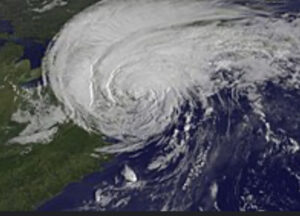 morning of June 3rd. The wind was relentless, uprooting trees as it went. At noon on June 4th, stores on the wharves were flooded in a surge up five feet deep. High winds howled through the Washington DC area. The storm then moved northeast past Nantucket on June 5th.
morning of June 3rd. The wind was relentless, uprooting trees as it went. At noon on June 4th, stores on the wharves were flooded in a surge up five feet deep. High winds howled through the Washington DC area. The storm then moved northeast past Nantucket on June 5th.
The storm reminded many people of the September gale of 1821, except that the September gale would have been much more common. There haven’t been many early June hurricanes in that area since 1825, but there have been a number of hurricanes to hit the area since, including Hurricane Sandy, which did much damage in New York City, including the subway area.
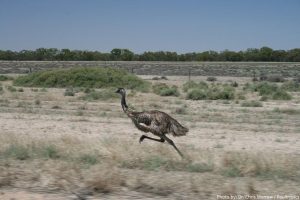 These days, it seems we are all aware of what an emu is, probably due to the Liberty Mutual commercials that are out there, but in 1932 Australia, these were a nuisance bird. They were everywhere and they were not popular. In fact, they were running amok in the Campion district of Western Australia, and the public was very concerned. They had made several attempts to curb the growth of the emu population, including the Australian soldiers being armed with Lewis guns…leading the media to adopt the name “Emu War” when referring to the incident. While a number of the birds were killed, the emu population persisted and continued to cause crop destruction.
These days, it seems we are all aware of what an emu is, probably due to the Liberty Mutual commercials that are out there, but in 1932 Australia, these were a nuisance bird. They were everywhere and they were not popular. In fact, they were running amok in the Campion district of Western Australia, and the public was very concerned. They had made several attempts to curb the growth of the emu population, including the Australian soldiers being armed with Lewis guns…leading the media to adopt the name “Emu War” when referring to the incident. While a number of the birds were killed, the emu population persisted and continued to cause crop destruction.
After World War I ended, the Australian government gave land to large numbers of ex-soldiers from Australia and the UK. The purpose of the gift was to take up farming within Western Australia, often in areas that had been counterproductive. When the Great Depression hit in 1929, these farmers were encouraged to increase their wheat crops. The government promised assistance in the form of subsidies, but later failed to deliver. In spite of the recommendations and the promised subsidies, wheat prices continued to fall, and by October 1932 matters were becoming critical, with the farmers preparing to harvest the season’s crops and threatening to refuse to deliver the wheat.
To make matters, the area was hit with the arrival of as many as 20,000 emus. This is apparently an annual event as the emus regularly migrate after their breeding season, heading to the coast from the inland regions. With the cleared land and additional water supplies being made available for livestock by the Western Australian farmers, the emus decided that the farmlands were a good, and closer habitat, and they began to foray into farm territory, especially in the marginal farming land around Chandler and Walgoolan. The emus began to eat and spoil the crops. In addition, they left large gaps in fences where rabbits could enter and cause further destruction.
When the farmers relayed their concerns about the birds ravaging their crops, and a group of the ex-soldiers were sent to meet with the Minister of Defense, Sir George Pearce. Something had to be done. Having served in World War I, the soldiers-turned-settlers were well aware of the effectiveness of machine guns, and they requested their deployment to fight this new enemy. The minister readily agreed, although with conditions attached: the guns were to be used by military personnel, troop transport was to be financed by the Western Australian government, and the farmers would provide food, accommodation, and payment for the ammunition. The farmers agreed and Pearce also supported the deployment on the grounds that the birds would make good target practice, while some in the government viewed the operation as a way of being seen to be helping the Western Australian farmers, as a way of staving off the secession movement that was brewing.
Sir George Pearce, who was later referred to in Parliament, as the “Minister of the Emu War” by Senator James Dunn, ordered the army to selectively thin the nuisance emu population…by large numbers. The “war” was scheduled to begin in October 1932, under the command of Major G P W Meredith of the Seventh Heavy Battery of the Royal Australian Artillery. Meredith was supposed to use troops armed with two Lewis guns and 10,000 rounds of ammunition, but the operation was delayed by a period of rainfall that caused the emus to scatter over a wider area. The rain finally stopped by November 2, 1932, and the troops were quickly deployed with orders to assist the farmers and, according to a newspaper account, to collect 100 emu skins so that their feathers could be used to make hats for light horsemen. On November 2nd, the men travelled to Campion, where some 50 emus were sighted. Unfortunately, when they got there, the birds were out of range of the guns. The local settlers attempted to herd the emus into an ambush, but the birds split into small groups and ran so that they were difficult to target. Nevertheless, while the first attack from the machine guns was ineffective due to the distance from the targets, a second round of gunfire was able to kill “a number” of birds. Later the same day, a small flock was encountered, and “perhaps a dozen” birds were killed.
The next significant event was on November 4th, when Meredith established an ambush near a local dam. More than 1,000 emus were spotted heading towards their position. This time the gunners waited until the birds were in close proximity before opening fire. The gun jammed after only twelve birds were killed and the rest scattered before any more could be shot. No more birds were sighted that day, so the decision was made to move further south, where the birds were “reported to be fairly tame.” The group had only limited success in spite of Meredith’s efforts. As the pursuit continued, it became apparent that “each pack seemed to have its own leader now…a big black-plumed bird which stands fully six feet high and keeps watch while his mates carry out their work of destruction and warns them of our approach.” In desperation, Meredith even went so far as to mount one of the guns on a truck. He was still ineffective, as the truck was unable to gain on the birds, and the ride was so rough that the gunner was unable to fire any shots, even if they had been able to get close. By November 8th, six days after the first attack, 2,500 rounds of ammunition had been fired. The number of birds killed is uncertain. One account estimates that it was 50 birds, but other accounts range from 200 to 500, the latter figure being provided by the settlers. Meredith’s official reported that there were no casualties among the men.
Summarizing the operation, ornithologist Dominic Serventy commented, “The machine-gunners’ dreams of point blank fire into serried masses of Emus were soon dissipated. The Emu command had evidently ordered guerrilla tactics, and its unwieldy army soon split up into innumerable small units that made use of the military equipment uneconomic. A crestfallen field force therefore withdrew from the combat area after about a month. On 8 November, members in the Australian House of Representatives discussed the operation. Following the negative coverage of the events in the local media, that included claims that “only a few” emus had died, Pearce withdrew the military personnel and the guns on 8 November.”
After the “Emu War” was over, Meredith compared the emus to Zulus and commented on the striking maneuverability of the emus, even while badly wounded. After the withdrawal of the military, the emu attacks on crops continued. Farmers again asked for support, citing the hot weather and drought that brought emus invading farms in the thousands. James Mitchell, the Premier of Western Australia lent his strong support to renewal of the military assistance. At the same time, a report from the Base Commander was issued that indicated 300 emus had been killed in the initial operation.
The killing continued periodically, with similar results. The Emu was just too fast, too aware, or too “lucky,” to be caught or killed. By December 1932, word of the Emu War had spread, reaching the United Kingdom.  Conservationists protested the cull as “extermination of the rare emu”. Dominic Serventy and Hubert Whittell, the eminent Australian ornithologists, described the “war” as “an attempt at the mass destruction of the birds”. Throughout 1930 and onward, the farmers tried exclusion barrier fencing as a means of keeping emus out of agricultural areas (in addition to other vermin, such as dingoes and rabbits). In November 1950, Hugh Leslie raised the issues of emus in federal parliament and urged Army Minister Josiah Francis to release a quantity of .303 ammunition from the army for the use of farmers. The minister approved the release of 500,000 rounds of ammunition. The emu continues to thrive today.
Conservationists protested the cull as “extermination of the rare emu”. Dominic Serventy and Hubert Whittell, the eminent Australian ornithologists, described the “war” as “an attempt at the mass destruction of the birds”. Throughout 1930 and onward, the farmers tried exclusion barrier fencing as a means of keeping emus out of agricultural areas (in addition to other vermin, such as dingoes and rabbits). In November 1950, Hugh Leslie raised the issues of emus in federal parliament and urged Army Minister Josiah Francis to release a quantity of .303 ammunition from the army for the use of farmers. The minister approved the release of 500,000 rounds of ammunition. The emu continues to thrive today.
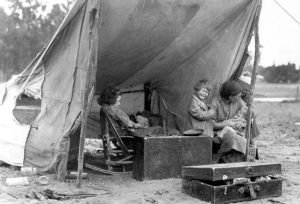
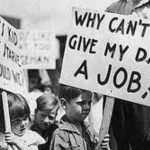 Following the Crash of 1929, which occurred on October 29, 1929, people quickly found that the jobs they thought were secure, were not only not secure, they were gone. That day became known as Black Tuesday. It was the day the stock market took a huge hit, as investors traded some 16 million shares on the New York Stock Exchange in a single day. Billions of dollars were lost, wiping out thousands of investors. The Great Depression followed the crash of 1929…banks failed, businesses closed, city streets were desolate, families lost their homes, and unemployment in rose to nearly 25%. The crash was the culmination of many years of economic instability. In the middle part of the United States, the depression occurred during the drought season. The farmers quickly lost their lands, because their crops died out, and many became migrant workers. They traveled around the country, hoping to find work for all members of the family in exchange for a meal or a place to sleep. Husbands and fathers traveled great distances from their homes in search of any work that they could find. There was no work…anywhere. Times were just about the worst they could possibly be.
Following the Crash of 1929, which occurred on October 29, 1929, people quickly found that the jobs they thought were secure, were not only not secure, they were gone. That day became known as Black Tuesday. It was the day the stock market took a huge hit, as investors traded some 16 million shares on the New York Stock Exchange in a single day. Billions of dollars were lost, wiping out thousands of investors. The Great Depression followed the crash of 1929…banks failed, businesses closed, city streets were desolate, families lost their homes, and unemployment in rose to nearly 25%. The crash was the culmination of many years of economic instability. In the middle part of the United States, the depression occurred during the drought season. The farmers quickly lost their lands, because their crops died out, and many became migrant workers. They traveled around the country, hoping to find work for all members of the family in exchange for a meal or a place to sleep. Husbands and fathers traveled great distances from their homes in search of any work that they could find. There was no work…anywhere. Times were just about the worst they could possibly be.
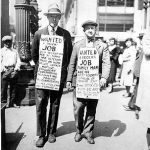
Architects, bankers, engineers and educators suddenly found themselves standing in long unemployment lines, competing for menial, basic jobs with pay that was barely enough to put food on their tables. Men who had defined themselves by taking care of their families, being the breadwinner, struggled with the emotional depression that came with the economic depression. As men traveled farther and farther away from home looking for jobs, they are forced to find lodging in public housing or shelters, waking up to begin job hunting again the next morning. Husbands and fathers who had previously earned enough money to feed and clothe their families were forced to stand in bread lines to receive free food so their families would not starve.
People became so desperate for work. As men went from town to town, they were met with billboard signs telling them to keep going, because there was no work in the town. Men with families even got their children involved, carrying signs asking why no one would hire their dad. Then men started wearing their resume on cardboard placards that they wore as they walked along. It seemed incredulous to the men who had been in higher paid jobs, that they could no longer find work…even with their qualifications. Signs like one saying, “I know 3 trades, I speak 3 languages, fought for 3 years, have 3 children and no work for 3 months. But I only 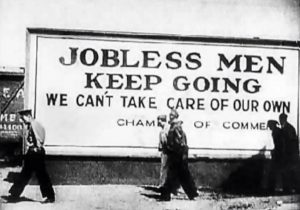
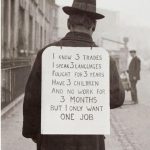 want one job,” appeared everywhere. Times couldn’t possibly get worse. While there’s no consensus about the exact end of the Great Depression among economic historians, the unemployment rate remained high for the rest of the 1930s, even as the banking crisis eased up. One major event, however, shifted the focus of the country away from the Great Depression. After the Japanese attack on Pearl Harbor on December 7, 1941, millions of men and women would join the work force as the US entered World War II.
want one job,” appeared everywhere. Times couldn’t possibly get worse. While there’s no consensus about the exact end of the Great Depression among economic historians, the unemployment rate remained high for the rest of the 1930s, even as the banking crisis eased up. One major event, however, shifted the focus of the country away from the Great Depression. After the Japanese attack on Pearl Harbor on December 7, 1941, millions of men and women would join the work force as the US entered World War II.
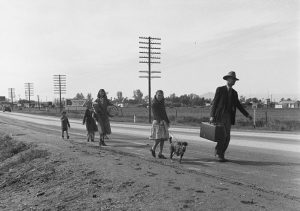
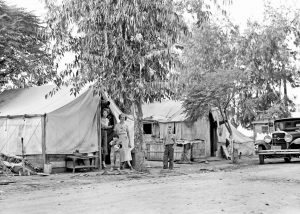 The “Dust Bowl” was an environmental disaster that hit the Midwest in the 1930s. A combination of a severe water shortage and harsh farming techniques caused the disaster. Some scientists believe it was the worst drought in North America in 300 years. The lack of rain killed the crops that kept the soil in place. When winds blew, they raised enormous clouds of dust. It deposited mounds of dirt on everything, even covering houses. With the Dust Bow came the failure of many farms in the Midwest, and the people had no choice but to move, in order to find a way to make a living.
The “Dust Bowl” was an environmental disaster that hit the Midwest in the 1930s. A combination of a severe water shortage and harsh farming techniques caused the disaster. Some scientists believe it was the worst drought in North America in 300 years. The lack of rain killed the crops that kept the soil in place. When winds blew, they raised enormous clouds of dust. It deposited mounds of dirt on everything, even covering houses. With the Dust Bow came the failure of many farms in the Midwest, and the people had no choice but to move, in order to find a way to make a living.
I suppose that the invasion that followed might have been similar to the current refugees. It wasn’t just one family that moved, but hundreds of families. Los Angeles Police Chief James E. Davis, seeking to halt the “invasion” of dust-bowl Depression refugees in February, 1936, declared a “Bum Blockade” to stop the mass emigration of poverty stricken families fleeing from the dust-torn states of the Midwest. These days, he would have met with severe criticism, not so much for the blockade, as for the name of the blockade.
By 1934, 75% of the United States was severely affected by this terrible drought. The region most affected was the Great Plains, and included more than 100 million acres, centered in Oklahoma, the Texas Panhandle, Kansas, and parts of Colorado and New Mexico. These millions of acres of farmland became useless and soon, hundreds of thousands of people were forced to leave their homes. Many of these destitute families packed up their belongings and migrated west, hoping to find work and a better life, about 200,000 of which were California bound. Instead of finding the promised land of their dreams, however, they found that the available labor pool was vastly disproportionate to the number of job openings that could be filled. Migrants who found employment soon learned that this surplus of workers caused a significant reduction in the going wage rate, and even when the entire family worked, they were unable to support themselves.
Many set up “ditchbank” camps along irrigation canals in the farmers’ fields, which brought with them poor sanitary conditions and created a public health problem. And, of those who could find work in agriculture, it did not put an end to their travels. Instead, their lives were characterized by transience, if they wanted to maintain a steady income, which required them to follow the various harvests around the state. In the meantime, California was overwhelmed, trying to figure out how to absorb as many as 6,000 migrants crossing its borders daily. Also feeling the effects of the Depression, California infrastructures were already overburdened, and the steady stream of newly arriving migrants was more than the system could bear. Though these refugees came from a number of states, Californians often lumped them together as “Okies” or “Arkies,” who became the butt of derogatory jokes and the focus of political campaigns in which candidates made them the scapegoat for a shattered economy. They were accused of many crimes, as well as shiftlessness, lack of ambition, school overcrowding and stealing jobs from native Californians.
California’s Indigent Act was passed in 1933, which made it a crime to bring indigent persons into the state, Davis contended that his men needed no special approval because “any officer has the authority to enforce the state law.” Asking border-county sheriffs to deputize his officers, most complied. However, some refused, including Modoc County, who forced 14 LAPD officers to leave after they turned away local residents trying to 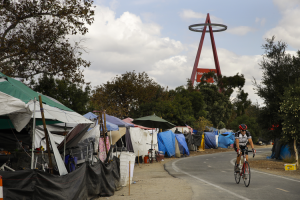
 return home. On August 24, 1935, the Los Angeles Herald-Express ran an article warning emigrants to stay away from California. It read: Stay Away From California: Warning To Transient Hordes. Those days were very different from the California of today, and not in a good way. I don’t agree with derogatory name calling, but common sense tells us that sometimes you have to try to stop a flood, even if it’s a flood of people.
return home. On August 24, 1935, the Los Angeles Herald-Express ran an article warning emigrants to stay away from California. It read: Stay Away From California: Warning To Transient Hordes. Those days were very different from the California of today, and not in a good way. I don’t agree with derogatory name calling, but common sense tells us that sometimes you have to try to stop a flood, even if it’s a flood of people.
 When a river is as wide as the Mississippi, and traveling through so many states, often through flat land, the potential for flooding always exists. I know that many people who live along the Mighty Mississippi, would never consider living anywhere else. They love that old river, and having been there myself, I can certainly understand why. The river views are beautiful. Still, the yearly potential for flooding is something that might put many people off, when it comes to living on the shores of that river. Of course, people can get flood insurance, and indeed, most banks would require it for properties along that river, but the possessions lost in floods, not to mention the time it takes to rebuild the homes, and especially the lives lost in floods, make living on the shores of the Mississippi something that I would probably not decide to do.
When a river is as wide as the Mississippi, and traveling through so many states, often through flat land, the potential for flooding always exists. I know that many people who live along the Mighty Mississippi, would never consider living anywhere else. They love that old river, and having been there myself, I can certainly understand why. The river views are beautiful. Still, the yearly potential for flooding is something that might put many people off, when it comes to living on the shores of that river. Of course, people can get flood insurance, and indeed, most banks would require it for properties along that river, but the possessions lost in floods, not to mention the time it takes to rebuild the homes, and especially the lives lost in floods, make living on the shores of the Mississippi something that I would probably not decide to do.
The Great Mississippi Flood of 1927 was the most destructive river flood in the history of the United States,  with 27,000 square miles inundated up to a depth of 30 feet. To try to prevent future floods, the federal government built the world’s longest system of levees and floodways. Of the more than 630,000 people affected by the flood, 94% lived in the states of Arkansas, Mississippi, and Louisiana, most in the Mississippi Delta. By August 1927, the flood subsided. Hundreds of thousands of people had been made homeless and displaced…properties, livestock and crops were destroyed. Some people left the area, because they did not have the money, or the stomach for living in an area where their homes could so easily be wiped out. Still, the draw of the beautiful Mississippi kept many people there, determined to rebuild their lives. Of course, the flood didn’t only affect the people living along the Mississippi. Lost crops affected many people in the United States. It was a disaster of epic proportions.
with 27,000 square miles inundated up to a depth of 30 feet. To try to prevent future floods, the federal government built the world’s longest system of levees and floodways. Of the more than 630,000 people affected by the flood, 94% lived in the states of Arkansas, Mississippi, and Louisiana, most in the Mississippi Delta. By August 1927, the flood subsided. Hundreds of thousands of people had been made homeless and displaced…properties, livestock and crops were destroyed. Some people left the area, because they did not have the money, or the stomach for living in an area where their homes could so easily be wiped out. Still, the draw of the beautiful Mississippi kept many people there, determined to rebuild their lives. Of course, the flood didn’t only affect the people living along the Mississippi. Lost crops affected many people in the United States. It was a disaster of epic proportions.
Then came the floods of the Mississippi and Missouri rivers in 1993, also known as the Great Flood of 1993. This is one that many of us alive today remember, mostly because we were old enough to remember, but also because the television and newspapers were filled with the stories of destruction. The flood was among the most costly and devastating to ever occur in the United States, with $15 billion in damages. The damage area  was more than 745 miles in length and 435 miles in width, totaling about 320,000 square miles. Within this zone, the flooded area totaled around 30,000 square miles and was the worst such US disaster since the Great Mississippi Flood of 1927, as far as duration, area flooded, persons displaced, crop and property damage, and number of record river levels. In some ways, the 1993 flood even surpassed the 1927 flood, which was, at the time, the largest flood ever recorded on the Mississippi River. The effects were felt by people all over the United States because of crops lost, the rise in the cost of building materials, and of course, insurance rates as a result of increased building material prices. Floods are nearly impossible to prevent, and for some people they are considered a risk they are willing to take, but for me, I think I’ll stick to places where the chance of a flood hitting my home is almost nil. On October 7, 1993, the Great Flood of 1993 came to an end as the Mississippi River finally started to recede, 103 days after the flooding began.
was more than 745 miles in length and 435 miles in width, totaling about 320,000 square miles. Within this zone, the flooded area totaled around 30,000 square miles and was the worst such US disaster since the Great Mississippi Flood of 1927, as far as duration, area flooded, persons displaced, crop and property damage, and number of record river levels. In some ways, the 1993 flood even surpassed the 1927 flood, which was, at the time, the largest flood ever recorded on the Mississippi River. The effects were felt by people all over the United States because of crops lost, the rise in the cost of building materials, and of course, insurance rates as a result of increased building material prices. Floods are nearly impossible to prevent, and for some people they are considered a risk they are willing to take, but for me, I think I’ll stick to places where the chance of a flood hitting my home is almost nil. On October 7, 1993, the Great Flood of 1993 came to an end as the Mississippi River finally started to recede, 103 days after the flooding began.
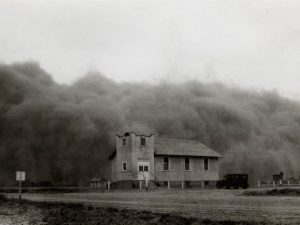
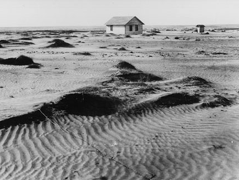 Drought…anywhere and at any time, is a perilous situation. Crops can’t grow, and food prices go up. But when a drought happens in the middle of an economic depression, it is catastrophic. The Dust Bowl, which was also known as the Dirty Thirties, was a period of severe dust storms during the 1930s. Mistakes were made during this drought…mistakes like a failure to implement dryland farming methods to prevent wind erosion caused the Dust Bowl. The drought came in three waves…1934, 1936, and 1939–40, but some regions of the high plains experienced drought conditions for as many as eight years. The people had no real understanding of the ecology of the plains. The farmers had plowed deep into the virgin topsoil of the Great Plains during the previous decade. This displacement of the native, deep-rooted grasses that normally trapped soil and moisture even during periods of drought and high winds were gone. During the drought of the 1930s, the unanchored soil turned to dust, which the prevailing winds blew away in huge clouds that sometimes blackened the sky. These choking clouds of dust…named “black blizzards” or “black rollers” traveled cross country. The Dust Bowl forced tens of thousands of families to abandon their farms.
Drought…anywhere and at any time, is a perilous situation. Crops can’t grow, and food prices go up. But when a drought happens in the middle of an economic depression, it is catastrophic. The Dust Bowl, which was also known as the Dirty Thirties, was a period of severe dust storms during the 1930s. Mistakes were made during this drought…mistakes like a failure to implement dryland farming methods to prevent wind erosion caused the Dust Bowl. The drought came in three waves…1934, 1936, and 1939–40, but some regions of the high plains experienced drought conditions for as many as eight years. The people had no real understanding of the ecology of the plains. The farmers had plowed deep into the virgin topsoil of the Great Plains during the previous decade. This displacement of the native, deep-rooted grasses that normally trapped soil and moisture even during periods of drought and high winds were gone. During the drought of the 1930s, the unanchored soil turned to dust, which the prevailing winds blew away in huge clouds that sometimes blackened the sky. These choking clouds of dust…named “black blizzards” or “black rollers” traveled cross country. The Dust Bowl forced tens of thousands of families to abandon their farms.
The drought, along with the already depressed economy, caused many people to have very little money. It was during this time that people had to get creative to meet their needs. Enter the flour sack…say what!! Yes, the flour sack. When the people didn’t have money for fabric to make clothing, they began to use the cloth flour sacks as material for clothing. Then, some industrious flour distributor somewhere decided to assist the people. The flour sacks began to have pretty designs on them. Just because the people were going to use the sacks for clothing, didn’t mean that they had to look like they were wearing a flour sack. It didn’t matter that everyone knew it was a flour sack either. It looked pretty, and that really helped with morale. In reality, cloth is cloth, but I suppose the flour sacks were not of the normal dress quality. Still, when that was all you had, you did what you had to do. When you are given lemons, make lemonade, and all…right.
As the flour sacks began to be prettier, the dresses became quite fashionable, and looking back on some of the dresses that were made, I doubt that most people would know the difference between a flour sack dress and any other dress…had they not been told. The people of those times really got quite creative in meeting the 
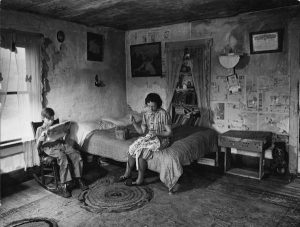 needs of the family…clothing, furniture, or even their houses…people persevered. Of course, food was a little bit more difficult in those days, because if the crops wouldn’t grow, you simply had to find something else to eat. I’m sure there were a lot of people who were pretty skinny in those days…as well as pretty hungry. Nevertheless, with the help of creative mothers, and industrious flour distributors, the girls looked very nice, and quite fashionable.
needs of the family…clothing, furniture, or even their houses…people persevered. Of course, food was a little bit more difficult in those days, because if the crops wouldn’t grow, you simply had to find something else to eat. I’m sure there were a lot of people who were pretty skinny in those days…as well as pretty hungry. Nevertheless, with the help of creative mothers, and industrious flour distributors, the girls looked very nice, and quite fashionable.
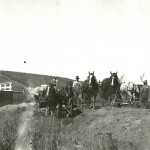 For any one whose ancestors came out to the West, homesteading probably is a word we know, and something we know a little about. Even if it is back in the history of our family, we knew that yes, the land was given to the homesteader, but in reality, they earned every blade of grass that was on their homestead. Homesteading was no easy way to live. Homesteading began when the United States government decided to give 65 acres to anyone who wanted to move out west and settle. They had to work the land for 5 years and then it became theirs. This all sounded like an amazing opportunity to many people, but there were many who came out west to get a homestead and then went back home before the 5 year timeframe was passed. They just couldn’t make it. The didn’t have what it takes. Homesteading was not a lazy man’s way to get land. This land was hard and full of rocks and trees. It had not been plowed and planted before. They would be the first to do that, and they didn’t have all the equipment we have these days to plow up the hard soil so it was suitable for growing crops on.
For any one whose ancestors came out to the West, homesteading probably is a word we know, and something we know a little about. Even if it is back in the history of our family, we knew that yes, the land was given to the homesteader, but in reality, they earned every blade of grass that was on their homestead. Homesteading was no easy way to live. Homesteading began when the United States government decided to give 65 acres to anyone who wanted to move out west and settle. They had to work the land for 5 years and then it became theirs. This all sounded like an amazing opportunity to many people, but there were many who came out west to get a homestead and then went back home before the 5 year timeframe was passed. They just couldn’t make it. The didn’t have what it takes. Homesteading was not a lazy man’s way to get land. This land was hard and full of rocks and trees. It had not been plowed and planted before. They would be the first to do that, and they didn’t have all the equipment we have these days to plow up the hard soil so it was suitable for growing crops on.
My grandparent were among those who came out and earned that homestead, by working that land and making it grow the crops they wanted it to grow. I doubt that they got by without ever losing a crop, because hail, drought, flood, fire, and tornados were bound to have happened at least once during that 5 year timeframe, but they stuck it out and made it work. They proved that they were tough enough to earn that homestead…to the government and to themselves.
Now, don’t get me wrong, I don’t think that the ones that went home were no good, they just didn’t have what it took to make it in the old west. This was rough country, and you  had to be tough to stick it out here. They had to learn to get along with the Indians too, because the Indians weren’t real happy with the White Man being here at all. Treaties had been broken to allow the west to be settled, and they didn’t like it one bit. I think we can all agree that this country was going to expand one way or the other, because as people have children and those children have children, and those children have children, and so on…well, more space was bound to be needed. Still, I suppose we should have handled it in a different way. Nevertheless, many White Men made peace with the Indians, and learned to live together. The White Man had come to the West. He was here to stay, because he had earned that homestead.
had to be tough to stick it out here. They had to learn to get along with the Indians too, because the Indians weren’t real happy with the White Man being here at all. Treaties had been broken to allow the west to be settled, and they didn’t like it one bit. I think we can all agree that this country was going to expand one way or the other, because as people have children and those children have children, and those children have children, and so on…well, more space was bound to be needed. Still, I suppose we should have handled it in a different way. Nevertheless, many White Men made peace with the Indians, and learned to live together. The White Man had come to the West. He was here to stay, because he had earned that homestead.

